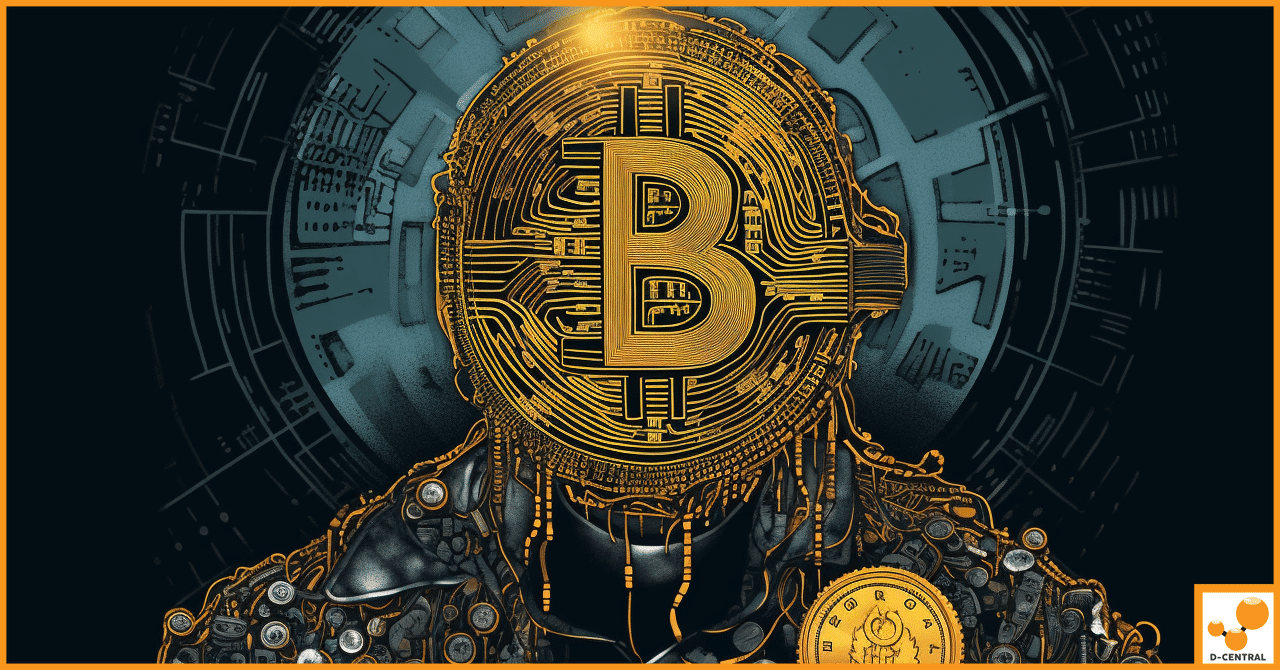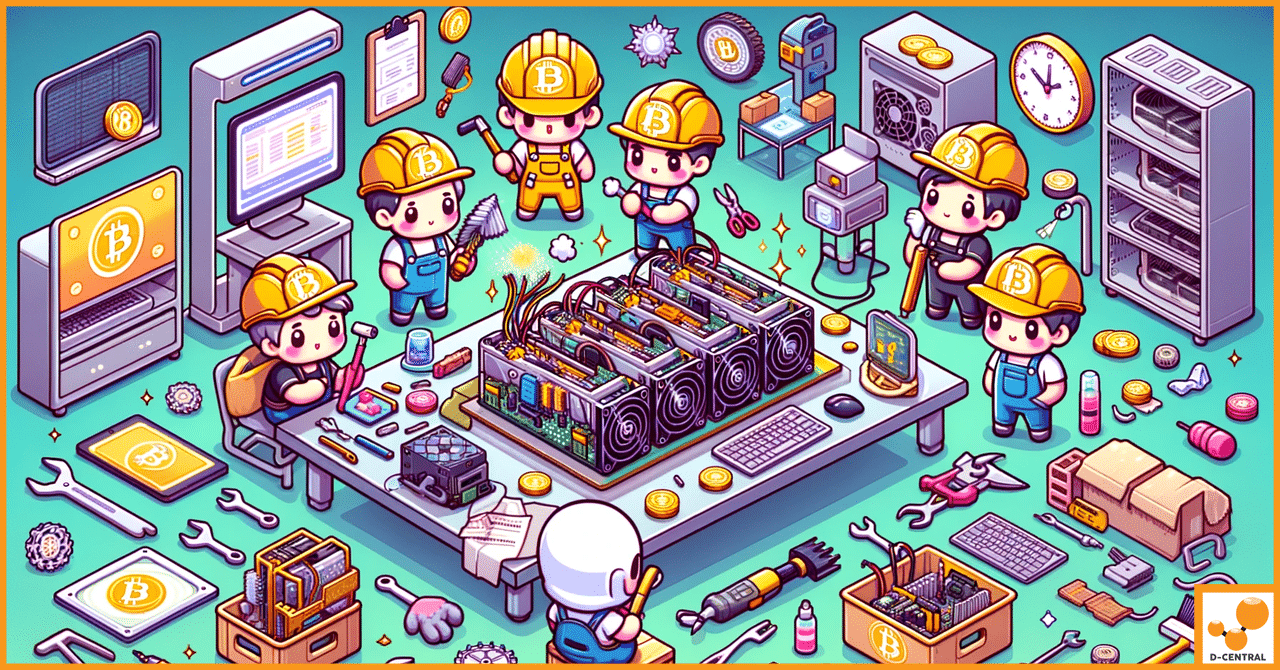
Decoding Bitcoin: A Cypherpunk’s Manifesto for Financial Freedom
In the digital realm, the cypherpunk movement has long been a vanguard for privacy, cryptography, and freedom from centralized authority.
4479 Desserte Nord Autoroute 440, Laval, QC H7P 6E2

In 1897, when Mark Twain was touring London, an American newspaper erroneously published his obituary. With his characteristic wit, Twain responded to this mishap by remarking, “The reports of my death are greatly exaggerated.” This humorous yet profound statement resonates strikingly with the current discourse surrounding Bitcoin mining, particularly the fears associated with the concept of a ‘Bitcoin Mining Death Spiral.’
Much like Twain’s premature obituary, the notion of a catastrophic collapse in Bitcoin mining due to declining prices and the halving events is often discussed with a sense of foreboding. However, just as Twain’s career was far from over, the resilience of Bitcoin mining is similarly underestimated.
The concept of Bitcoin halving plays a central role in these discussions. Approximately every four years, the reward for mining a Bitcoin block is halved, an event that is both anticipated and feared within the mining community. This mechanism, embedded in the heart of Bitcoin’s protocol, is designed to control the issuance of new coins, mimicking the scarcity and value preservation akin to precious metals like gold. However, with each halving, concerns surface about the profitability and sustainability of mining activities. Will the reduced rewards lead to a mass exodus of miners? Could this trigger a domino effect, destabilizing the entire Bitcoin network?
As we delve deeper into this topic, it’s essential to separate fact from fiction and understand the true dynamics at play in Bitcoin mining, a field where D-Central Technologies has established itself as a leader and innovator. Just as Mark Twain’s legacy endured beyond the rumors of his demise, the so-called ‘Death Spiral’ of Bitcoin mining warrants a closer examination to reveal the underlying truths and dispel the myths.
Bitcoin halving is a fundamental process built into the very architecture of Bitcoin itself, serving as a key mechanism to control inflation and emulate the scarcity dynamics of precious resources. At its core, Bitcoin halving is a scheduled reduction in the rewards that miners receive for adding new blocks to the blockchain, an event that occurs approximately every four years, or after every 210,000 blocks have been mined.
The inception of Bitcoin in 2009 came with a reward of 50 BTC for each block mined. This reward remained until November 2012, when the first halving occurred, reducing the reward to 25 BTC. The second halving in July 2016 further reduced this to 12.5 BTC. Most recently, in May 2020, the third halving brought the reward down to 6.25 BTC. This predictable schedule of halving is a critical aspect of Bitcoin’s economic model, ensuring a total cap of 21 million Bitcoins ever to be in existence.
The concept of halving directly impacts miners’ profitability. On the surface, the halving of rewards seems to suggest a potential decrease in income for miners. After all, halving the reward appears to halve the incentive. However, the reality is more nuanced. The historical context shows us that each halving event has been followed by significant fluctuations in Bitcoin’s price. While the immediate aftermath of a halving may see a dip in miner revenue, the long-term effect often balances this out with an increase in the value of Bitcoin itself.
This phenomenon can be attributed to the basic principles of supply and demand. As the reward for mining decreases, the rate at which new Bitcoins are created slows down, leading to reduced supply. If the demand for Bitcoin remains strong or increases, the reduced supply can lead to a higher value per Bitcoin. This potential increase in value can offset the reduced block reward, maintaining or even increasing miners’ profitability in the long term.
In essence, Bitcoin halving is a double-edged sword for miners. It presents a short-term challenge in terms of immediate rewards but also holds the potential for long-term gain as the market adjusts to the new supply rate. This delicate balance is a testament to the ingenious design of Bitcoin’s economic model, ensuring its sustainability and stability over time.
At D-Central Technologies, understanding and adapting to these market dynamics is a cornerstone of our strategy, enabling us to provide top-tier services and support to our clients in navigating the ever-evolving landscape of Bitcoin mining.
The ‘Death Spiral’ theory in Bitcoin mining is a concept that has garnered significant attention, often shrouded in misunderstanding and fear. To debunk this myth, it’s crucial to first understand what the theory entails and then examine why it is largely a misconception.
The Death Spiral theory posits that a significant drop in Bitcoin’s price, particularly following a halving event, could make mining unprofitable. This situation could theoretically lead to a mass exodus of miners, drastically reducing the network’s hash rate. The reduced hash rate would extend the time required to mine new blocks, slowing down transaction confirmations and potentially causing further panic and sell-offs. This vicious cycle could, in theory, lead to a complete collapse of the Bitcoin network, hence the term ‘Death Spiral.’
However, this theory overlooks several critical aspects of Bitcoin’s design and the behavior of its mining community:
In conclusion, the Bitcoin Mining Death Spiral is more myth than reality. The network’s built-in difficulty adjustment, combined with the strategic behavior of miners and the resilience shown during past events, all work together to ensure the stability and longevity of Bitcoin mining. At D-Central Technologies, we understand these dynamics deeply, allowing us to guide our clients through the complexities of Bitcoin mining with confidence and expertise.
At D-Central Technologies, we pride ourselves on being at the forefront of the Bitcoin mining revolution. Our expertise and innovative approach have positioned us as a leader in this dynamic industry, offering a comprehensive range of services that cater to both newcomers and seasoned miners.
Our journey in the Bitcoin mining sector is marked by a deep understanding of the industry’s nuances and a commitment to staying ahead of the curve. We recognize that Bitcoin mining is not just about powerful hardware but also about the knowledge and strategy behind its use. This understanding drives our approach to service delivery, ensuring that we offer solutions that are not only technologically advanced but also strategically sound.
One of our key offerings is our ASIC training services. We believe that empowering our clients with knowledge is crucial for their success in Bitcoin mining. Our training programs are designed to cater to various levels of expertise, from beginners who are just stepping into the world of Bitcoin mining to seasoned miners looking to enhance their skills. These services cover a wide range of topics, including ASIC maintenance, optimization, and effective mining strategies, ensuring our clients are well-equipped to manage and optimize their mining operations.
At D-Central, we understand the importance of reliable and efficient mining hardware. We offer a broad spectrum of high-quality mining equipment, tailored to meet the diverse needs of any mining operation. Our commitment to excellence is reflected in our competitive pricing and the cutting-edge technology of our products. Whether you are starting a new mining operation or scaling an existing one, we have the right equipment to ensure your venture’s success.
Recognizing the challenges of managing mining operations, D-Central offers comprehensive hosting solutions in our state-of-the-art facilities located in Quebec and Alberta. These facilities are designed specifically for ASIC hosting, providing optimal conditions for mining operations. Our hosting services manage the critical aspects of temperature, power, and security, allowing our clients to focus on
their core mining activities while we ensure smooth and efficient performance of their hardware.
In the ever-evolving landscape of Bitcoin mining, staying informed and making strategic decisions is key to success. This is where D-Central’s consulting services come into play. Our team of experts, active in the industry since 2016, specializes in providing strategic insights and tailored advice. We help our clients navigate through the complexities of the market, keeping them updated on industry trends, legislation, and technological innovations. Our consulting services are designed to equip miners with the tools and knowledge necessary to make informed decisions and achieve their mining goals in this dynamic market.
Understanding that each mining operation has unique needs, D-Central offers A La Carte services, providing the ultimate flexibility in Bitcoin mining solutions. Whether it’s strategic insights, optimized hosting solutions, skill development, or state-of-the-art equipment, each service is available independently to meet our clients’ immediate requirements. This tailored approach ensures that our clients receive exactly what they need to optimize their mining ventures.
At D-Central Technologies, our commitment to innovation, expertise, and comprehensive service offerings sets us apart in the Bitcoin mining industry. We are dedicated to supporting our clients through every step of their mining journey, providing them with the tools, knowledge, and resources needed to succeed in this competitive landscape. Our pioneering role in the Bitcoin mining revolution is a testament to our unwavering dedication to excellence and our clients’ success.
In the realm of Bitcoin mining, understanding market dynamics and the application of game theory is crucial. This perspective not only provides insights into miner behavior but also helps in debunking myths like the Bitcoin Mining Death Spiral. At D-Central Technologies, we leverage these concepts to offer strategic guidance and optimize mining operations for our clients.
Game theory, a study of strategic decision-making, plays a significant role in Bitcoin mining. It involves understanding how miners, as rational actors, make decisions that are not only based on their individual circumstances but also on the anticipated actions of others in the network. This interplay of decisions significantly influences
the overall health and stability of the Bitcoin network.
Miners constantly evaluate the profitability of mining Bitcoin versus other cryptocurrencies. This evaluation is influenced by factors such as the current price of Bitcoin, the cost of electricity, the efficiency of their mining equipment, and the network’s mining difficulty. When some miners find it less profitable to mine Bitcoin and switch to other cryptocurrencies, it temporarily decreases the network’s hash rate. However, this also makes mining Bitcoin easier and potentially more profitable for those who remain. This self-regulating mechanism ensures a balance in the network, preventing the so-called ‘Death Spiral.’
The behavior of miners is also influenced by broader market dynamics. For instance, when the price of Bitcoin falls, it might initially seem less profitable to mine. However, long-term players and institutional miners, who view their operations as a long-term investment, might continue mining or even increase their mining capacity. They do this in anticipation of future price increases, accumulating Bitcoin when the network competition is lower.
Moreover, the Bitcoin network’s difficulty adjustment mechanism plays a critical role in stabilizing the mining environment. Every 2016 blocks, or approximately every two weeks, the network adjusts the difficulty of mining new blocks. This ensures that the average time between blocks remains close to 10 minutes, regardless of the total hash power of the network. This adjustment can make mining more profitable for those who continue to mine, even when others have dropped out due to lower Bitcoin prices.
At D-Central Technologies, we closely monitor these market dynamics and apply our insights to help our clients make informed decisions. Our understanding of game theory and miner behavior allows us to provide strategic advice, ensuring that our clients can navigate the complexities of Bitcoin mining effectively. We help them understand when it might be beneficial to increase mining efforts or diversify their mining activities, based on current market conditions and future projections.
Understanding the interplay of market dynamics and game theory in Bitcoin mining is essential for any successful mining operation. At D-Central Technologies, we use these insights to guide our clients through the ever-changing landscape of Bitcoin mining, helping them to avoid common pitfalls and capitalize on opportunities. This strategic approach is a key factor in our clients’ success and the stability of the Bitcoin network as a whole.
The landscape of Bitcoin mining has been dramatically transformed by technological advancements and a relentless pursuit of efficiency. At D-Central Technologies, we are at the forefront of this evolution, continuously integrating the latest technological innovations to enhance the efficiency and effectiveness of Bitcoin mining operations.
The progression in mining technology, particularly in ASIC (Application-Specific Integrated Circuit) miners, has been a game-changer. These specialized devices are designed exclusively for Bitcoin mining, offering unparalleled efficiency compared to earlier mining equipment. The evolution from CPU, GPU, and FPGA mining to ASIC miners represents a significant leap in hashing power and energy efficiency, enabling miners to achieve higher hash rates while consuming less power.
Energy efficiency is a critical aspect of modern Bitcoin mining, given the environmental concerns and the cost of electricity. The latest ASIC miners are not only more powerful but also more energy-efficient, reducing the overall environmental footprint of mining operations. This shift towards energy-efficient technology is crucial in making Bitcoin mining more sustainable and cost-effective.
At D-Central, we specialize in providing custom solutions tailored to the unique needs of our clients. Our expertise lies in modifying and optimizing existing mining hardware to enhance its performance and efficiency. One of our notable innovations is the development of Bitcoin Space Heaters. These devices are a creative adaptation of refurbished ASIC miners, repurposed to provide heating solutions while mining Bitcoin. This dual-purpose approach exemplifies our commitment to innovation, sustainability, and efficiency in Bitcoin mining.
Understanding that each mining operation has its specific requirements, we offer customized solutions to our clients. This includes on-demand modifications to the stock settings and parts of ASIC miners, making them compatible with various operational environments. Whether it’s adapting miners for home use with silent fans or tweaking them for 120V compatibility, our goal is to ensure that our clients’ mining setups are as efficient and effective as possible.
The advancements in mining technology and the pursuit of efficiency are reshaping the Bitcoin mining industry. D-Central Technologies is at the heart of this transformation, offering cutting-edge solutions and custom modifications to meet the evolving needs of miners. Our innovative approach, including the development of Bitcoin Space Heaters, demonstrates our commitment to pushing the boundaries of what’s possible in Bitcoin mining, ensuring our clients are equipped with the best tools to succeed in this competitive landscape.
The landscape of Bitcoin mining is not just shaped by technology and market dynamics but also significantly influenced by the strategies of various players, especially institutional miners. Their approach during periods of price fluctuations plays a pivotal role in maintaining the resilience of the Bitcoin market. At D-Central Technologies, we recognize and support the diverse strategies of both large-scale institutional miners and individual miners, ensuring stability and growth in the mining ecosystem.
Institutional miners, often equipped with substantial capital and resources, tend to adopt a long-term perspective in their Bitcoin mining operations. Unlike smaller miners who might be more sensitive to immediate market fluctuations, these large-scale miners are better positioned to weather short-term volatility in Bitcoin prices. This resilience is part of a broader strategy where institutional miners view their operations as a long-term investment rather than a quick profit venture.
During periods when the cost of mining exceeds the immediate value of Bitcoin, these miners often continue their operations, anticipating future price rebounds. This approach is not just a gamble on rising prices but a calculated decision based on market analysis and trends. By continuing to mine during these periods, institutional miners accumulate Bitcoin, positioning themselves to capitalize on potential future price increases.
At D-Central Technologies, we understand the varying needs and strategies of different types of miners. Our services and solutions are designed to cater to the entire spectrum of the mining community.
The resilience of the Bitcoin market, particularly during price fluctuations, is a testament to the diverse strategies of its participants. Institutional miners play a crucial role in this ecosystem, bringing stability and long-term investment perspectives. D-Central Technologies is committed to supporting the entire mining community, from large-scale institutional operations to individual miners, ensuring that everyone has the tools and knowledge needed to succeed in the dynamic world of Bitcoin mining. Our comprehensive range of services and solutions reflects our dedication to fostering a resilient and thriving mining ecosystem.
In exploring the intricacies of Bitcoin mining, we have journeyed through various facets that shape this dynamic industry. From debunking the myth of the Bitcoin Mining Death Spiral to highlighting the advanced technological solutions and strategies employed by miners, it’s clear that the Bitcoin mining ecosystem is robust, resilient, and constantly evolving.
The notion of a Bitcoin Mining Death Spiral has been thoroughly examined and dispelled. Key factors such as the Bitcoin network’s difficulty adjustment mechanism, the strategic behavior of miners, and the resilience shown during past market fluctuations, all contribute to the stability of the Bitcoin mining ecosystem. These elements ensure that the network remains secure and functional, even amidst varying market conditions.
At D-Central Technologies, our commitment to the Bitcoin mining community is unwavering. We understand the challenges and opportunities within this sector and are dedicated to providing comprehensive support to miners of all scales. Our services range from offering state-of-the-art mining equipment and hosting solutions to providing in-depth ASIC training and tailored consulting services.
The journey of Bitcoin mining is one of continuous adaptation and growth. As the industry evolves, D-Central Technologies remains committed to being at the forefront, providing the tools, knowledge, and support needed for success in this exciting field. Join us in navigating the future of Bitcoin mining, where innovation, resilience, and community come together to forge a path of sustained success and growth.
What is the ‘Bitcoin Mining Death Spiral’?
The ‘Bitcoin Mining Death Spiral’ refers to a theoretical scenario where a significant drop in Bitcoin’s price after a halving event makes mining unprofitable, leading to a mass exodus of miners, reducing the network’s hash rate, and destabilizing the entire Bitcoin network.
What is Bitcoin halving?
Bitcoin halving is an event that occurs approximately every four years where the reward for mining a Bitcoin block is halved. It’s designed to control the issuance of new coins and mimic scarcity akin to precious metals like gold.
How does Bitcoin halving impact miners’ profitability?
Bitcoin halving impacts miners’ profitability by reducing the rewards miners receive for adding new blocks. However, this reduction can be offset by an increase in the value of Bitcoin, balancing long-term profitability.
Why is the Bitcoin Mining Death Spiral considered a misconception?
It’s considered a misconception due to Bitcoin’s difficulty adjustment mechanism, historical network resilience, strategic miner behavior, and the stability brought in by institutional miners during market fluctuations.
What role does D-Central Technologies play in the Bitcoin mining industry?
D-Central Technologies provides a comprehensive range of services for Bitcoin mining, including ASIC training, advanced mining equipment, hosting solutions, consulting services, and custom solutions for different types of mining operations.
How does market dynamics and game theory apply to Bitcoin mining?
Market dynamics and game theory play a crucial role in Bitcoin mining. Miners’ strategic decision-making based on profitability and network competition ensures a balance in the network and prevents a collapse.
How does D-Central Technologies support different types of miners?
D-Central Technologies supports large-scale institutional miners with hosting and consulting services and helps individual and small-scale miners by providing efficient hardware, educational resources, and tailored solutions.
DISCLAIMER: D-Central Technologies and its associated content, including this blog, do not serve as financial advisors or official investment advisors. The insights and opinions shared here or by any guests featured in our content are provided purely for informational and educational purposes. Such communications should not be interpreted as financial, investment, legal, tax, or any form of specific advice. We are committed to advancing the knowledge and understanding of Bitcoin and its potential impact on society. However, we urge our community to proceed with caution and informed judgment in all related endeavors.
Related Posts

In the digital realm, the cypherpunk movement has long been a vanguard for privacy, cryptography, and freedom from centralized authority.

In the rapidly evolving world of Bitcoin mining, the Antminer S19 XP stands out as a beacon of efficiency and

In the ever-evolving landscape of cryptocurrency mining, the efficiency and longevity of mining hardware stand as pivotal factors determining the